Following a nearly three day journey, an Orbital Sciences Corp. Cygnus commercial cargo freighter carrying a ton and a half of science experiments and supplies for the six person crew was successfully installed onto the International Space Station at 8:53 a.m. EDT this morning, July 16, after a flawless arrival and being firmly grasped by station astronauts deftly maneuvering the Canadarm2 robotic arm some two hours earlier.
Cygnus was captured in open space at 6:36 a.m. EDT by Commander Steve Swanson as he maneuvered the 57-foot (17-meter) Canadarm2 from a robotics workstation inside the station’s seven windowed domed Cupola, after it was delicately flown on an approach vector using GPS and LIDAR lasers to within about 32 feet (10 meters) of the massive orbiting complex.
Swanson was assisted by ESA astronaut and fellow Expedition 40 crew member Alexander Gerst working at a hardware control panel.
“Grapple confirmed” radioed Houston Mission Control as the complex soared in low orbit above Earth at 17500 MPH.
“Cygnus is captured as the ISS flew 260 miles (400 km) over northern Libya.”
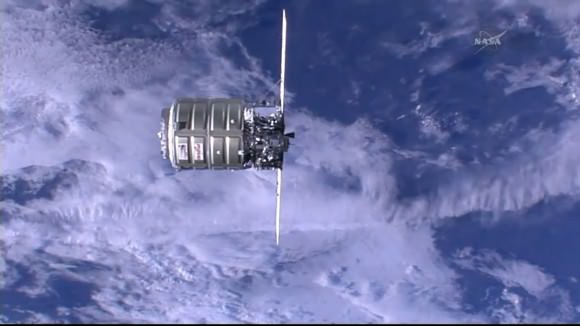
Cygnus by the book arrival at the million pound orbiting laboratory coincided with the 45th anniversary of the launch of Apollo 11 on July 16, 1969 on America’s first manned moon landing mission.
This mission dubbed Orbital-2, or Orb-2, marks the second of eight operational cargo resupply missions to the ISS under Orbital’s Commercial Resupply Services (CRS) contract with NASA.
The supplies are critical to keep the station flying and humming with research investigations.
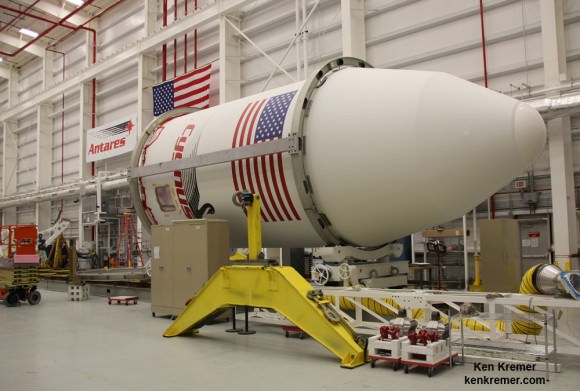
The supply ship thrusters all worked perfectly normal during rendezvous and docking to station with streaming gorgeous views provided by the stations new high definition HDEV cameras.
“We now have a seventh crew member. Janice Voss is now part of Expedition 40,” radioed Swanson.
“Janice devoted her life to space and accomplished many wonderful things at NASA and Orbital Sciences, including five shuttle missions. And today, Janice’s legacy in space continues. Welcome aboard the ISS, Janice.”
The Cygnus spacecraft was christened “SS Janice Voss” in honor of Janice Voss who flew five shuttle missions during her prolific astronaut carrier, worked for both NASA and Orbital Sciences and passed away in February 2012.
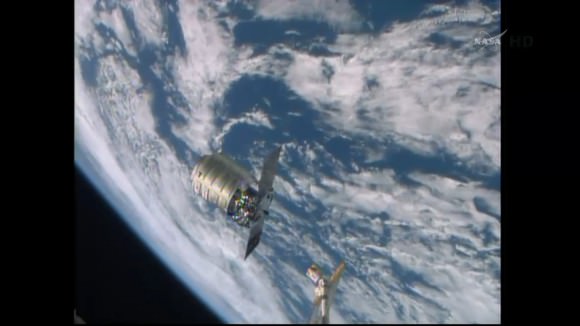
A robotics officer at Mission Control in Houston then remotely commanded the arm to move Cygnus into place for its berthing at the Earth-facing port on the Harmony module.
Once Cygnus was in place at the ready to latch (RTF) position, NASA astronaut and Flight Engineer Reid Wiseman monitored the Common Berthing Mechanism operations and initiated the first and second stage capture of the cargo ship to insure the craft was firmly joined.
The hard mate was completed at 8:53 a.m. EDT as the complex was flying about 260 miles over the east coast of Australia. 16 bolts were driven to firmly hold Cygnus in place to the station.
“Cygnus is now bolted to the ISS while flying 260 miles about the continent of Australia,” confirmed Houston Mission Control.
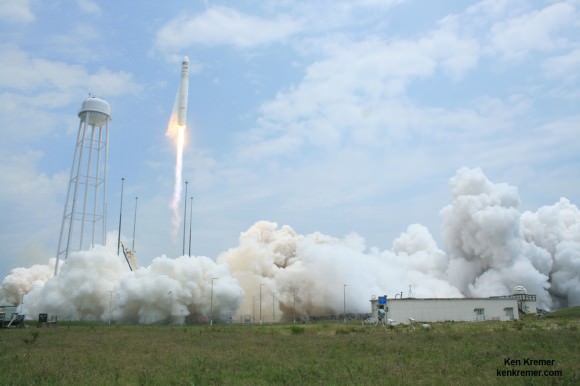
Cygnus roared to orbit during a spectacular blastoff on July 13 atop an Orbital Sciences Corp. Antares rocket on the Orb-2 mission at 12:52 p.m. (EDT) from the beachside Pad 0A at the Mid-Atlantic Regional Spaceport on NASA’s Wallops Flight Facility on the Eastern Shore of Virginia.
The US/Italian built pressurized Cygnus cargo freighter delivered 1,657 kg (3653 lbs) of cargo to the ISS Expedition 40 crew including over 700 pounds (300 kg) of science experiments and instruments, crew supplies, food, water, computer equipment, spacewalk tools and student research experiments.
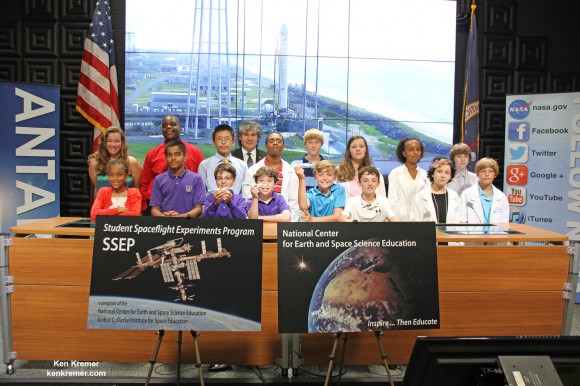
Science experiments from these students representing 15 middle and high schools across America were selected to fly aboard the Orbital Sciences Cygnus Orb-2 spacecraft which launched to the ISS from NASA Wallops, VA, on July 13, 2014, as part of the Student Spaceflight Experiments Program (SSEP). Credit: Ken Kremer – kenkremer.com
The crew will begin work today to remove the Centerline Berthing Camera System that provided the teams with a view of berthing operations through the hatch window.
Swanson will then pressurize and outfit the vestibule area between Harmony and Cygnus. After conducting leak checks they will open the hatch to Cygnus either later today or tomorrow and begin the unloading process, including retrieving a stash of highly desired fresh food.
The wide ranging science cargo and experiments includes a flock of 28 Earth imaging nanosatellites and deployers, student science experiments and small cubesat prototypes that may one day fly to Mars.
“Every flight is critical,” said Frank Culbertson, Orbital’s executive vice president of the advanced programs group, at a post launch briefing at NASA Wallops. Culbertson was a NASA shuttle commander and also flew aboard the International Space Station (ISS).
“We carry a variety of types of cargo on-board, which includes food and basic supplies for the crew, and also the research.”
The cargo mission was crucial since the crew supply margin would have turned uncomfortably narrow by the Fall of 2014.
Cygnus will remain attached to the station approximately 30 days until August 15.
For the destructive and fiery return to Earth, the crew will load Cygnus with approximately 1,340 kg (2950 lbs) of trash for disposal upon atmospheric reentry over the Pacific Ocean approximately five days later after undocking.
The Orb-2 launch was postponed about a month from June 9 to conduct a thorough re-inspection of the two Russian built and US modified Aerojet AJ26 engines that power the rocket’s first stage after a test failure of a different engine on May 22 at NASA’s Stennis Space Center in Mississippi resulted in extensive damage.
The July 13 liftoff marked the fourth successful launch of the 132 foot tall Antares in the past 15 months, Culbertson noted.
The first Antares was launched from NASA Wallops in April 2013. And the Orb-2 mission also marks the third deployment of Cygnus in less than a year.
Orbital Sciences was awarded a $1.9 Billion supply contract by NASA to deliver 20,000 kilograms (44,000 pounds) of research experiments, crew provisions, spare parts and hardware for 8 flights to the ISS through 2016 under the Commercial Resupply Services (CRS) initiative.
Stay tuned here for Ken’s continuing ISS, OCO-2, GPM, Curiosity, Opportunity, Orion, SpaceX, Boeing, Orbital Sciences, MAVEN, MOM, Mars and more Earth & Planetary science and human spaceflight news.

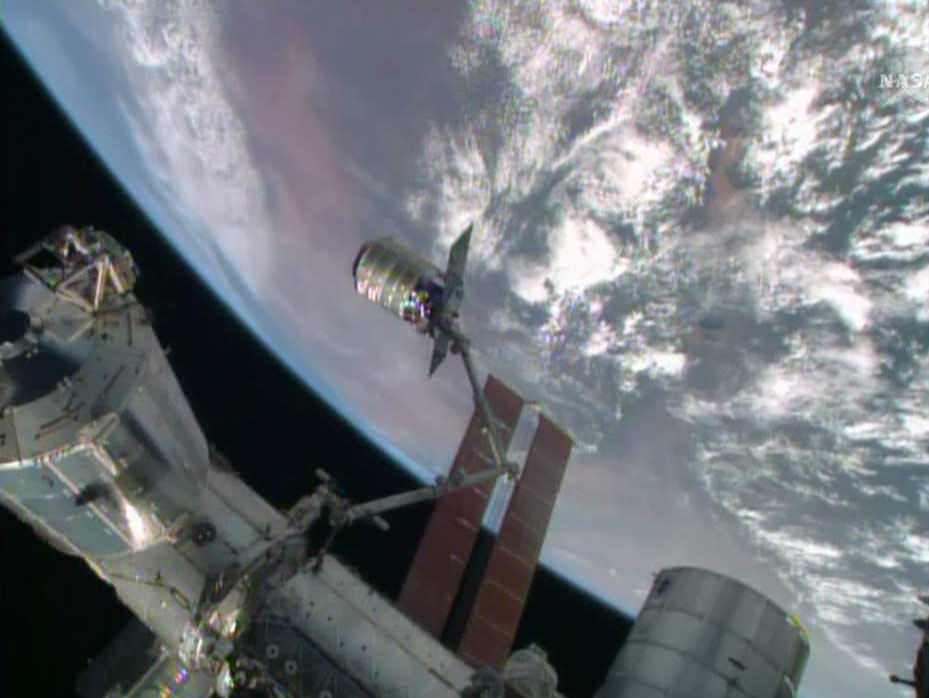
A ton and a half, or a tonne and a half? I ask because it’s actually about tonne and a half (1600 kg). It’s 1.8 short (American) tons though. Which is closer to 2 US tons.
tons (long) vs tons (short) vs tonnes (SI) is so darned annoying:P.
Leesee now.. The Cygnus capsule can carry 3,653 lbs, of cargo to the ISS. The Progress capsule 5,200 lbs. The Dragon carries 7,300 lbs. The HTV 14,770 lbs. And finally the heaviest lifter is the ATV at 16,903 lbs. The Dragon of course, has re-entry capacity while the HTV and ATV program managers debate doing the same with their vehicles.
The big question for me would of course be… How much of that 3,633 lbs is fresh food? Any beer? ~@; )